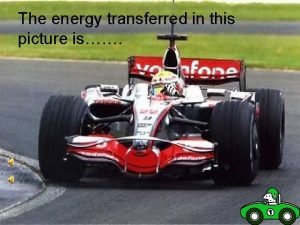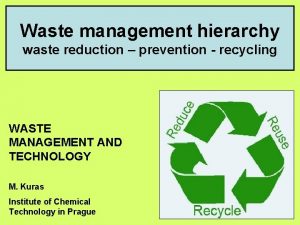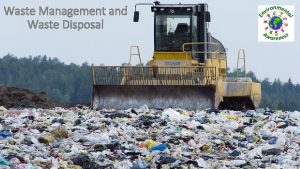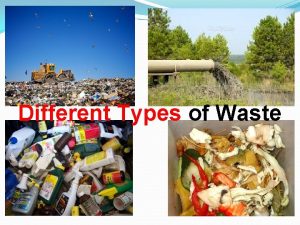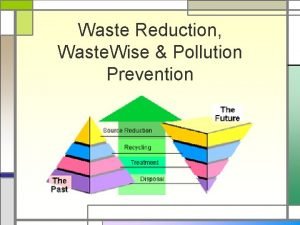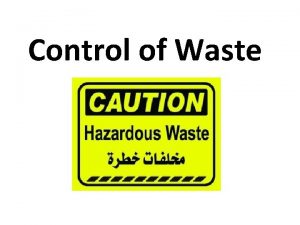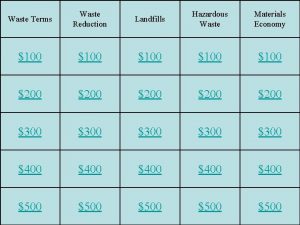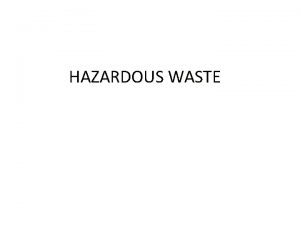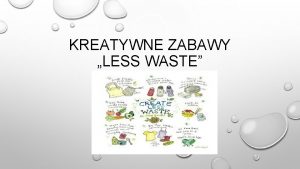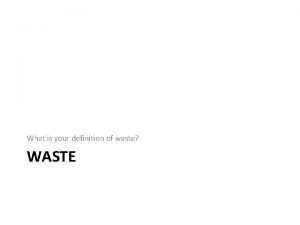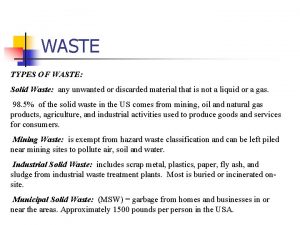Waste management Waste to energy June 2013 1





















- Slides: 21

Waste management Waste to energy June 2013 1

Waste management Avoiding waste production Reducing its hazards Selective collection, waste utilisation, recycling ►► Reducing landfills 2

Waste handling Physical handling (e. g. classification, filtering) Chemical handling (e. g. neutralisation) Biological handling (e. g. aerob and anaerob decomposition – biogas) Thermal handling processes 3

Waste to Energy Waste-to-energy (Wt. E) or energy-from-waste (Ef. W) is the process of generating energy in the form of electricity and/or heat from waste. Wt. E is a form of energy recovery. Most Wt. E processes produce electricity and/or heat directly through incineration, or produce a combustible fuel commodity, such as methane, methanol, ethanol or synthetic fuels. 4

Comparison of technologies 5

Wt. E in figures The quantity of waste produced all over the world amounted to: more than 12 billion tonnes in 2006, up to 13 billion tonnes in 2011, up to 18 billion tonnes by year 2020. Huge potential! Around 130 million tonnes of municipal solid waste (MSW) are combusted annually in over 600 waste-to-energy (WTE) facilities globally, that produce electricity and steam for district heating and recovered metals for recycling. Incineration, with energy recovery, is the most common waste-to-energy method employed worldwide. Over the last five years, waste incineration in Europe has generated between an average of 4% to 8% of their countries’ electricity demand between an average of 10% to 15% of the continent’s domestic heat demand. Europe had more than 475 WTE plants across its regions – more than any other continent in the world – that processes an average of 59 million tonnes of waste per annum. http: //www. bioenergyconsult. com/category/waste-to-energy/ 6

MSW and RDF MSW: Municipal solid waste Varies greatly from country to country and changes significantly with time: - intractable wastes such as plastic film, and un-recyclable packaging - food wastes, yard wastes, containers and product packaging, and other miscellaneous wastes from residential, commercial, institutional, and industrial sources. But: Do not include industrial wastes, agricultural wastes, medical waste, radioactive waste or sewage sludge. Refuse-derived fuel (RDF) is a fuel produced by shredding and dehydrating solid waste (MSW) with a Waste converter technology. RDF consists largely of combustible components of municipal waste such as plastics and biodegradable waste. RDF processing facilities are normally located near a source of MSW at a remote location. 7

1. Pyrolysis is a thermochemical decomposition of organic material at elevated temperatures in the absence of oxygen. New and emerging technologies that are able to produce energy from waste and other fuels (or combustible fuel commodity) without direct combustion. 8

2. Incineration Concerns regarding the operation of incinerators: fine particulate, heavy metals, trace dioxin and acid gas emissions. Ethics: Whether they may reduce the incentives for recycling and waste minimization activities? Answer: Europe recycling the most (up to 70%) also incinerate their residual waste to avoid landfilling. Efficiencies: Incinerators have electric efficiencies in the order of 14 -28%. The total efficiencies of cogeneration incinerators are typically higher than 80%. The weight of residues after incineration is 10 -15% of the wastes feeded. 9

Japan and China built several plants that were based on direct smelting or on fluidized bed combustion of solid waste. In China there about 50 Wt. E plants. Japan is the largest user in thermal treatment of MSW in the world with 40 million tons. During the 2001 -2007 period, the Wt. E capacity increased by about four million metric tons per annum. 10

Use of heat and electricity The heat produced by an incinerator can be used to generate steam which may then be used to drive a turbine in order to produce electricity. The typical amount of net energy that can be produced per tonne municipal waste is about: 2/3 MWh of electricity, and 2 MWh of heating/cooling. Thus, incinerating about 600 metric tons per day of waste will produce about 400 MWh of electrical energy per day (17 MW of electrical power continuously for 24 hours) and 1200 MWh of heating (cooling) energy a day. 11

Incineration technologies TechnologyWaste type MSW RDF Whole tires Cut tires A. Grate technology x x x B. Rotary klin x x C. Fluidised bed x x 12

A. Grate technologies Waste utilisation plant of Budapest 13

Incinerates 60 -65% of MSW of the capital town of Hungary, Budapest. Capacity is 420, 000 tonnes per annum. Supplies heat for 13, 000 flat, And electricity for 45, 000 flat. Fulfills all the EU environmental and emission regulations 14

B. Rotary kiln Rotary klin furnace incinerator with afterburner chamber, heat recovery boiler and flue gas cleaner: • Waste feeding • Rotating furnace with start-up burner and air supply • Natural gas afterburner with air supply • De. NOx system (SNCR) • Heat recovery boiler • Feeding system with deairator tank and feeding pumps • Flue gas cleaning with dry washer and filters • Handling of flue gas cleaning additives • Flue gas suction-fan and stack • Ash and flying ash removal • Electric and C&I system 15

Technological scheme of a 30, 000 t/a RDF fired plant (rotary kiln) 16

C. Fluidised bed 17

Technological scheme of a 30, 000 t/a RDF fired plant (fluidised bed) 18

3 D view of a solid material fired small power plant with 7 MW electric capacity Cooling tower Stack Raw and fire water tank Boiler house Solid fuel 1 Turbine hall Solid fuel 2 19

Data Area: 150 m x 150 m Operator staff: 40 Budget price in Europe for a fluidised bed incineration plant per k. W electric capacity: 3, 000 - 4, 000 USD/k. W e 20

Thank you for your attention! Name: Istvan Pataki Email: pataki@innocell. hu 21
 Energy energy transfer and general energy analysis
Energy energy transfer and general energy analysis Energy energy transfer and general energy analysis
Energy energy transfer and general energy analysis Release management
Release management Wheelabrator technologies inc
Wheelabrator technologies inc Energy transfer picture
Energy transfer picture 30 days has september april june and november
30 days has september april june and november Spanish flacs exam 2018 answers
Spanish flacs exam 2018 answers June 2010 physics regents answers
June 2010 physics regents answers June 2005 calendar
June 2005 calendar Mitsl
Mitsl Good morning 1 june
Good morning 1 june What does lottery in june corn be heavy soon
What does lottery in june corn be heavy soon June 2010 chemistry regents
June 2010 chemistry regents Welcome june blessings
Welcome june blessings Summary period: june 2021 jack
Summary period: june 2021 jack Grade 7 life orientation test
Grade 7 life orientation test Good morning welcome june
Good morning welcome june June 21 2019 geometry regents answers
June 21 2019 geometry regents answers Flacs checkpoint b spanish exam june 2017 answers
Flacs checkpoint b spanish exam june 2017 answers Cxc 2018 results
Cxc 2018 results Biography of britney spears
Biography of britney spears Sunny june poem
Sunny june poem




